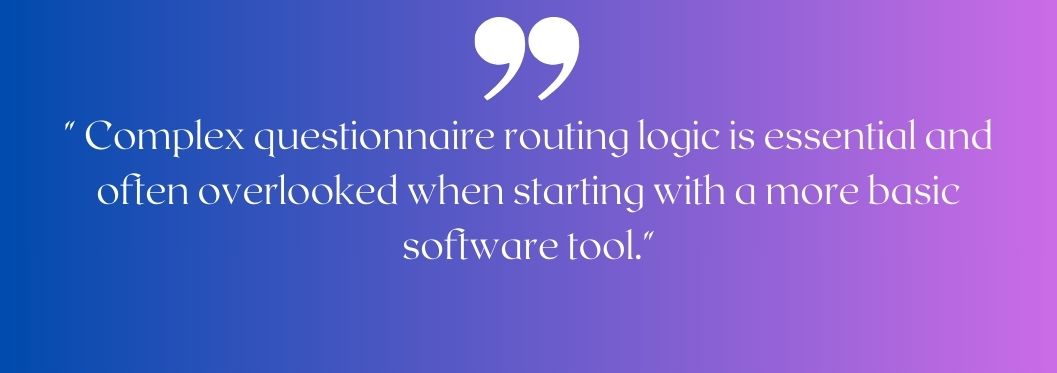
Phil Hearn: Blogger, Writer & Founder of MRDC Software Ltd.
10 essential things when choosing online survey software
Choosing the right software for your online surveys gets harder. The market is flooded with several free or low-cost products which, rightly or wrongly, get to the top of the search engines simply because more people want to do small, quick surveys than professional market research or customer feedback. To make it worse, if you search for the ‘best online survey software’, you will likely get a list of low-cost products or comparisons of these low-cost products.
Who this blog article is aimed at
So, let’s be clear. This blog article is not aimed at people or organisations wishing to conduct a quick poll amongst friends, club members or even a small team. Plenty of free tools can probably do the job at little or no cost, particularly when there is no complexity and survey appearance is unimportant. However, the more serious you become at carrying out surveys, the more likely you will need to consider the 10 essential things described in this article. This is not an exhaustive list – you may need specific features due to your own circumstances. These are, in my view, the minimum things you should, at least, consider seriously.
Scripting vs. User Interface is not discussed here!
This article focuses on functionality and what you need to conduct professional online surveys, especially when providing a service to clients, rather than as an internal exercise. Therefore, the issue of comparing online software systems that use scripting rather than a user interface is not relevant here and is more dependent on a) the volume of projects, b) the skills of your team, c) whether you have special needs or highly complex needs, d) possibly, your budget. However, you rarely need high-ticket products to produce good-quality surveys with all the functions you need to be successful.
1. Good security
Security isn’t an exciting topic to start with, but it is nonetheless highly important. With data privacy established as a major consideration, the storage of personal data needs appropriate recognition. Most online survey software providers will have a privacy and security statement on their website. I am suspicious of vague terms like ‘we consider security important’; I prefer facts like certifications, independent auditing and clearly worded policy. ISO27001 is the recognised gold standard for data and information security. If you are conducting a survey on behalf of a mid-size or larger company, they are likely to want assurances about security. Failing to consider this point at the outset could mean losing business later. If you are storing data, you will need to act responsibly.
2.Flexible themes
Response rates for online surveys are falling. It’s easy to see why – there are too many surveys. Your survey needs to stand out. Your chances of potential respondents completing the survey are substantially increased if the questionnaire looks good and has a ‘clean’ appearance. Good online survey software should provide you with templates and the ability to change the theme. It doesn’t have to be super-complicated. Indeed, a neat, clean look is often more attractive, but it needs to look professional. You should be able to adjust colours, layout and style effortlessly. You don’t need a design studio here, but enough to make the survey look good.
3. A range of question types
You will likely want more question types than you might initially think. You will want, as a minimum, questions where one answer is allowed, questions where any number of responses are permitted (multiple-response questions), questions collecting numbers (with or without a decimal point), open text questions where a respondent can type what they wish, rating scales where you have a list of statements or items with the same responses, questions that can use pictures or video or have pictures as responses, and questions where you can place answers in rank order. That’s quite a list, but they will all come into play. Additionally, you may want to have ways for respondents to upload audio, images or video, depending on the types of survey you handle. It should also be possible to allow respondents to not answer some questions – a surprising number of survey tools insist on an answer for every question. Respondents sometimes can’t remember or do not wish to divulge certain information.
4. A variety of appearances
Making a questionnaire more interactive will encourage respondents to complete your survey, especially where the subject matter is not especially interesting for the respondent. Here are two examples. Firstly, using images for answers can make a survey more interesting. Similarly, long rating-scale questions, or too many, can quickly become tedious. Respondents may give up or answer rating scales as quickly as possible with minimal thought or without reading the statements carefully. Displaying rating scales in different ways within a questionnaire can make the task more engaging. There should be tools like sliders and sort piles where statements or items can be dragged into piles – tools that make the task more interactive and engaging for respondents.
Keep respondents engaged
Research has shown that respondents are likelier to complete an engaging, longer survey than a shorter, boring one. You, therefore, need tools to keep it interesting. Rating scales are tempting to put in, but they can produce the least accurate results and are one of the leading causes of respondents dropping out.
5. Powerful routing tools/skipping questions
Complex questionnaire routing logic is essential and often overlooked when starting with a more basic software tool. You may want to ask a question of those who have bought a brand and have seen it advertised in the last year but not in the previous month. Such logic sounds simple but may be beyond the scope of some systems.
6. Good question-handling tools
This is a more difficult category to define. You will soon find that you need some flexibility on how questions are presented. If you have a long list of brands, for example, there will be a risk that respondents choose the brands nearest the top of the list. To balance this, it would be wise to randomise the order of the brands or reverse the order for half the sample. Text substitution is another example (sometimes called piping). Let’s say a respondent has chosen Weetabix as their favourite cereal at Question 1. The text for a subsequent question, especially if it is on a previous screen, must pull in the word Weetabix, such as ‘What do you like about Weetabix’s packaging?’ You do not want the question text to read, ‘What do you like about the packaging of the brand you mentioned at Question 1?’ Or worse still, ‘What do you like about the packaging?’ Tools like this soon become essential if you are conducting professional research. Another example is a list of brands at the end of which you want to have an option for respondents to choose ‘none of these’. A respondent shouldn’t be able to select a brand and ‘none of these’. It doesn’t make sense. A good range of tools should cover this type of eventuality.
7. Flexible data outputs
I’m disappointed that some software tools do little more than provide limited analysis with the option to output data as a spreadsheet in Excel or CSV format. This is not good enough. Excel is a good tool for quick counts or lists, while pivot tables offer no more than a limited way to produce basic (and inflexible) crosstabulations. It should be possible to output data to Triple-S or SPSS format as a minimum. These are two formats that most survey analysis programs can read. Triple-S is an independent standard that well over 50 software tools can read, while SPSS is a proprietary format many software packages can handle. However, if you have a preferred data analysis tool, it is worth checking (and testing) how easy it is to move data between the systems. For some products, it is easy; for others, it is more cumbersome than you might expect or impossible.
8. Sufficient analysis and reporting
The amount of analysis and reporting you need will likely depend on the deliverables your clients expect and whether you prefer to use another platform for your main analysis and reporting. I think quick counts on any question and basic crosstabs are essential, but this may depend on your workflow and other considerations. Similarly, charting and reporting may be desirable or critical, but, at the very least, it should be easy to transfer or copy/paste figures into Excel/PowerPoint for graphical representation. These types of tasks should be straightforward and not a convoluted process.
9. Mobile friendly
Much internet access is made by smartphones and tablets. It is essential that your questionnaire looks good on a PC, tablet and smartphone. Respondents should have to scroll as little as possible to view responses. A good online software product will allow you to customise the appearance of each type of device. It is sometimes important to abbreviate the text, for example, when the questionnaire is completed on a smartphone. Images look fine on a PC or tablet, but text may look better on a smartphone. A survey tool should be able to recognise the device being used and adapt satisfactorily.
10. Project sharing
Non-survey tools have become increasingly collaborative, making it easier to share information. This expectation has rightly spread to survey tools. It should be easy to share questionnaires, share data, view project progress and so on. Some platforms charge an extra fee for this type of facility, but it should be free or inexpensive, in my view.
So, here’s my list of 10 essentials. If you’ll excuse me, I will add an eleventh one, which is gaining momentum.
11. Links to external databases
Having collected some valuable survey data, linking it to external and customer databases is becoming more critical. Similarly, interacting with external databases, either to act as input for a survey or to take output from a survey, is gaining importance. Many platforms do not have these tools available. With the growing need for automation, outputting data directly into an external system that can automatically update a business dashboard, for example, is becoming more of an expectation.
Now compare the software you are considering.
How well does the survey platform you use or are considering measure up on these criteria? We have partnered with Snap Surveys because they passed our test of essential features. Other products will pass this test, but many don’t, and I believe you will likely need all 10 of my essentials. In fact, Snap offers a lot more. Talk to our sales team if you need more information now! Simply email sales@mrdcsoftware.com.








